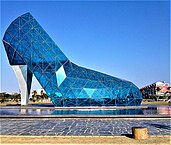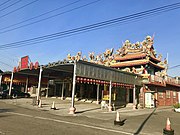Budai (Chiayi)
|
Budai 布袋 鎮 |
||
 Location of Budais in the Chiayi district |
||
| State : |
|
|
| County : | Chiayi | |
| Coordinates : | 23 ° 22 ′ N , 120 ° 10 ′ E | |
| Area : | 61.7307 km² | |
| Residents : | 26,381 (Dec 2019) | |
| Population density : | 427 inhabitants per km² | |
| Time zone : | UTC + 8 (Chungyuan time) | |
| Telephone code : | (+886) (0) 5 | |
| Postal code : | 625 | |
| ISO 3166-2 : | TW-CYQ | |
| Community type : | City municipality ( 镇 , Zhèn ) | |
| Structure : | 23 districts ( 里 , Li ) | |
| Website : | ||
|
|
||
Budai ( Chinese 布袋 鎮 , Pinyin Lùcǎo Xiāng ) is a township ( 镇 , Zhèn ) in Chiayi County in the Republic of China in Taiwan .
location
Budai is located in the very southwest of Chiayi County and the Jianan Plain on the cross-strait coast . The common land consists of alluvial land deposited by the river Bazhangxi ( 八掌溪 ), which also forms the southern boundary of Budai. Budai is strongly characterized by its coastal location. There is a fishing, trading and marina and a mangrove nature reserve. The neighboring communities are Dongshi in the north, Puzi in the northeast, Yizhu in the east, and the Beien District of Tainan in the south.
history
An older name of Budai is Budairui ( 布岱瑞 , Bùdàiruì ). In the 17th and 18th centuries, Budairui was an important port and destination for immigrants from mainland China. After the Sino-Japanese War of 1894/95, Taiwan became part of Japan. The Japanese understood the local Hokkien dialect poorly and transcribed the place name with a similar sound, but with the characters 布袋 嘴 , Bùdàizuǐ , meaning “bag mouth”. Later, the Japanese administration shortened all Taiwanese place names to a maximum of two characters, so that Budaizui ultimately became Budai , the “sack”, or the “cloth bag”. It has stayed with this name to this day. After Taiwan was taken over by the Republic of China , Budai became a township ( 镇 , Zhèn ) on October 18, 1948 , initially in Tainan County and from 1950 in the newly established Chiayi County.
In earlier times Budai was an important center of sea salt production. In addition, Budai was one of the endemic areas of black foot disease in Taiwan (see below).
population
The population consists predominantly of Hoklo . Members of indigenous peoples make up only a small proportion of the population (114 people at the end of 2019, corresponding to 0.4%).
| Outline of Budai |

|
Administrative division
Budai is divided into 23 districts ( 里 , Li ):
1 Jiulong ( 九龍 里 )
2 Daijiang ( 岱 江 里 )
3 Cenhai ( 岑 海里 )
4 Xingzhong ( 興 中 里 )
5 Longjiang ( 龍江 里 )
6 Xincuo ( 新厝 里 )
7 Zhenliao ( 振 寮 里 )
8 Jianlong ( 見 龍 里 )
9 Guangfu ( 光復 里 )
10 Haomei ( 好 美 里 )
11 Fuxing ( 復興 里 )
12 Xinmin ( 新民 里 )
13 Xincen ( 新 岑 里 )
14 Yong'an ( 永安 里 )
15 Donggang ( 東 港 里 )
16 Jiangshan ( 江山里 )
17 Caipu ( 菜 舖 里 )
18 Shulin ( 樹林 里 )
19 Guishe ( 貴 舍 里 )
20 Zhong'an ( 中 安 里 )
21 Dong'an ( 東 安 里 )
22 Kaoshi ( 考試 里 )
23 Xi'an ( 西安里 )
economy
The most important economic factor are the ports of Budai. From the commercial port ( 布袋 港 , Bùdài gǎng , officially 布袋 國內 商港 , Bùdài guónèi shānggǎng - "Inland Commercial Port Budai" ) there are regular ferry connections to Magong on the Penghu Archipelago . There is also the fishing port ( 布袋 渔港 , Bùdài yúgǎng ) and a small marina ( 布袋 游艇 码头 , Bùdài yóutǐng mǎtóu ).
![]()
![]()
![]()
Water spinach is harvested in the Budai lagoons . The fishing industry is based on the one hand on aquaculture (oysters, milk fish , eel, Japanese clams , shrimp ) and on the other hand on deep sea fishing (shrimp, Scomberomorus niphonius , torpedo mackerel , flatfish , Trichiurus lepturus , squid ). Agricultural products are rice, sugar cane , corn, millet , melons, vegetables and ornamental flowers. Goose breeding is carried out.
traffic
Provincial expressway 69 runs parallel to the coast in north-south direction. A little further inland, provincial road 17 also runs from north to south, which joins the former in the south of Budai. From the northeast, the county road 161 leads to the province road 17. There are also several county roads that run in an east-west direction: in the north the 170, in the middle the 172 and in the south the 163.
particularities
A tourist destination is the fish market ( 布袋 港 漁 市 , Bùdài gǎng yúshì ) with a nearby auction hall in the district of Cenhai. The salt mountain ( 鹽山 ) in the district of Longjiang is reminiscent of the previously important salt extraction from the sea.
![]()
![]()
There are several well-known temples in Budai. Every year on the 27th day of the third lunar month, celebrations are held in honor of Wangye ( 王爺 , Wángyé ). The center of activities, which include a procession through the water, is the Xinwen Jiaying Temple ( 新 塭 嘉應 廟 , Xīn wēn jiā yīng miào ) in the district of Fuxing. In the Taisheng Temple ( vere 聖宮 , Tàishèng gōng ) in the district of Haomei, whose beginnings go back to the 18th century, the sea goddess Mazu is worshiped. Larger events in honor of the goddess are held here in the third lunar month. In Guoguo-Jiande Temple ( 過溝建德宮 , Guogou Jiande gōng ), Xi'an many gods are worshiped. The main celebrations take place on 25/26. Day of the fourth lunar month and the last three days of the sixth lunar month.
![]()
![]()
![]()
A building that has also gained international fame is the Stöckelschuh Church ( 高跟鞋 教堂 , Gāogēnxié Jiàotáng , English High-Heel Wedding Church ) in Cenhai. Although it is dubbed a “church”, the building has no religious function. The building is intended to commemorate the endemic black foot disease that used to occur in Budai and the surrounding communities (Beimen, Xuejia and Yinzhu) . The cause of the disease was chronic arsenic poisoning , which was caused by the naturally increased arsenic content of the deep groundwater. The disease led to necrosis on the extremities and made amputations z. B. the feet necessary. It has practically disappeared completely since the introduction of a central water supply in the 1960s.
![]()
In the Haomeiliao wetland ( 好 美 寮 溼 地 , Hǎoměiliáo shīdì ) is a small nature reserve in the district of the same name. Here you will find sandbars, lagoons, small coastal forests and mangrove forests .
![]()
Web links
Individual evidence
- ↑ a b 關於 布袋 鎮 (About Budai Municipality). Budai Municipality website, accessed April 14, 2020 (traditional Chinese).
- ↑ 認識 布袋 (Learn more about Budai). Budai Municipality website, accessed April 14, 2020 (traditional Chinese).
- ↑ 歷史 沿革 (history). Budai Municipality website, accessed April 14, 2020 (traditional Chinese).
- ↑ 似懂非懂: 魚米之鄉 - 台南 (上) . HyRead (Chinese, limited preview in Google Book Search - "The Land of Fish and Rice - Tainan (Part 1)").
- ↑ 文化 資產> 布袋 鹽場 沿革 (Cultural assets> History of the Budai Salt Flats). Budai Municipality website, accessed April 14, 2020 (traditional Chinese).
- ↑ a b 台灣 烏 腳 病 醫療 紀念館 Taiwan Blackfoot Disease Socio-Medical Service Memorial House. Website of the memorial house, accessed on May 9, 2019 (Chinese (traditional), English).
- ↑ 原住民 戶數 及 人數 Households and Persons of Indigenous People. (xls) Taiwan Ministry of the Interior, accessed April 18, 2020 (Chinese, English).
- ↑ 行政 區域 圖 (administrative area map). Budai website, accessed April 17, 2020 (Chinese (traditional)).
- ^ Budai Tourist Fish Market. taiwan.net.tw (Taiwan Tourism Board), accessed April 18, 2020 .
- ^ Budai Tourist Fish Market. Cultural and Tourism Authority of the Chiayi County, accessed on April 18, 2020 (English).
- ^ Budai Salt Fields. Southwest Coast National Landscape Area, December 10, 2015, accessed April 18, 2020 .
- ↑ 20190501 新 塭 嘉應 廟 衝 水路 拍攝. Retrieved April 18, 2020 (Chinese (traditional), procession on the occasion of the Mazu festival in Budai (YouTube)).
- ↑ Xinwen Jiaying Temple. Cultural and Tourism Authority of the Chiayi County, accessed on April 18, 2020 (English).
- ↑ a b c 布袋 知名 廟宇 (Well-known temples in Budai). Budai website, accessed April 18, 2020 (Chinese (traditional)).
- ↑ Taisheng Temple. Culture and Tourism Authority of Chiayi County, November 9, 2017, accessed on April 18, 2020 (English).
- ↑ Huang Kuo-fang, Elaine Hou: Taiwan seeking record title for 'high-heel church'. Focus Taiwan, June 4, 2016, accessed April 17, 2020 .
- ↑ Haomeiliao Nature Reserve. Culture and Tourism Authority of Chiayi County, November 9, 2017, accessed on April 18, 2020 (English).





